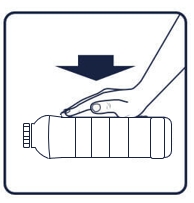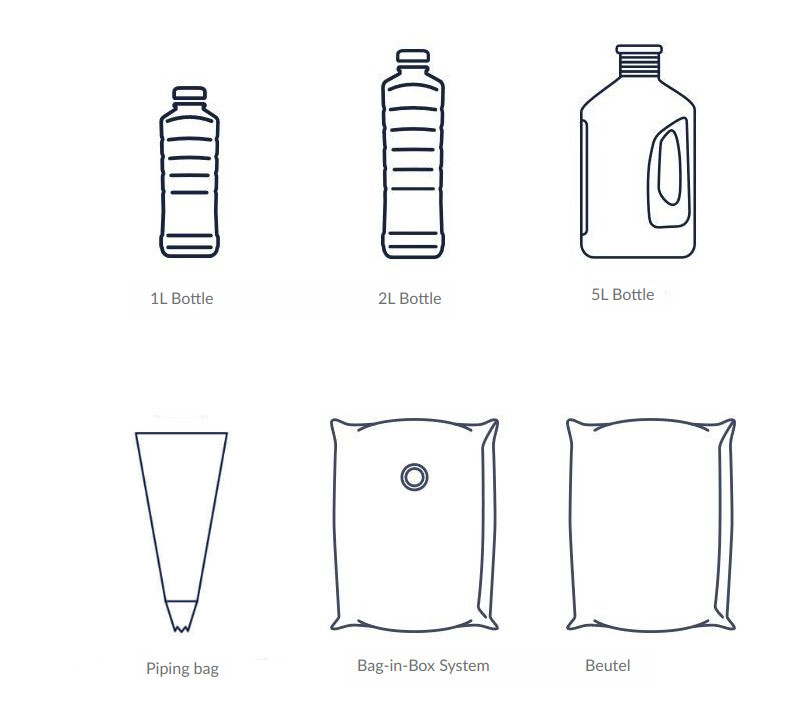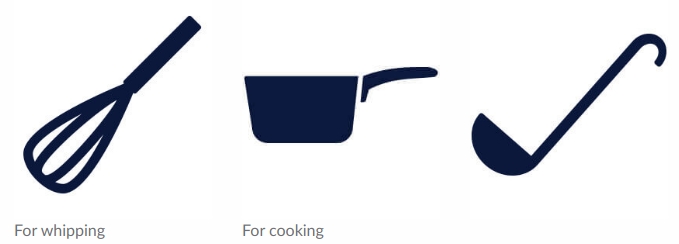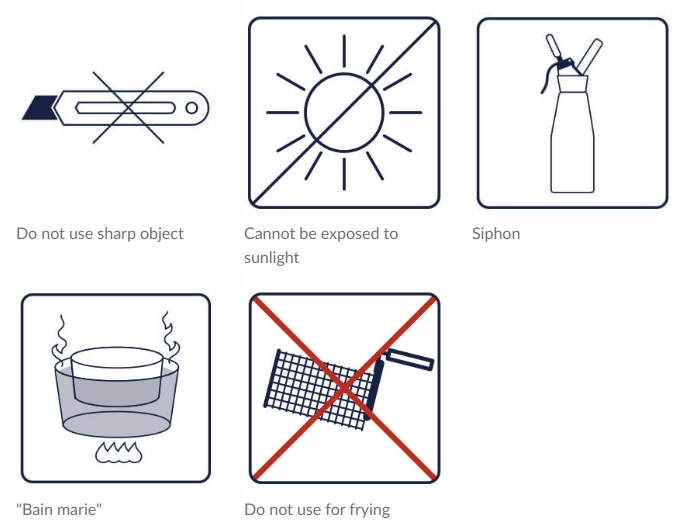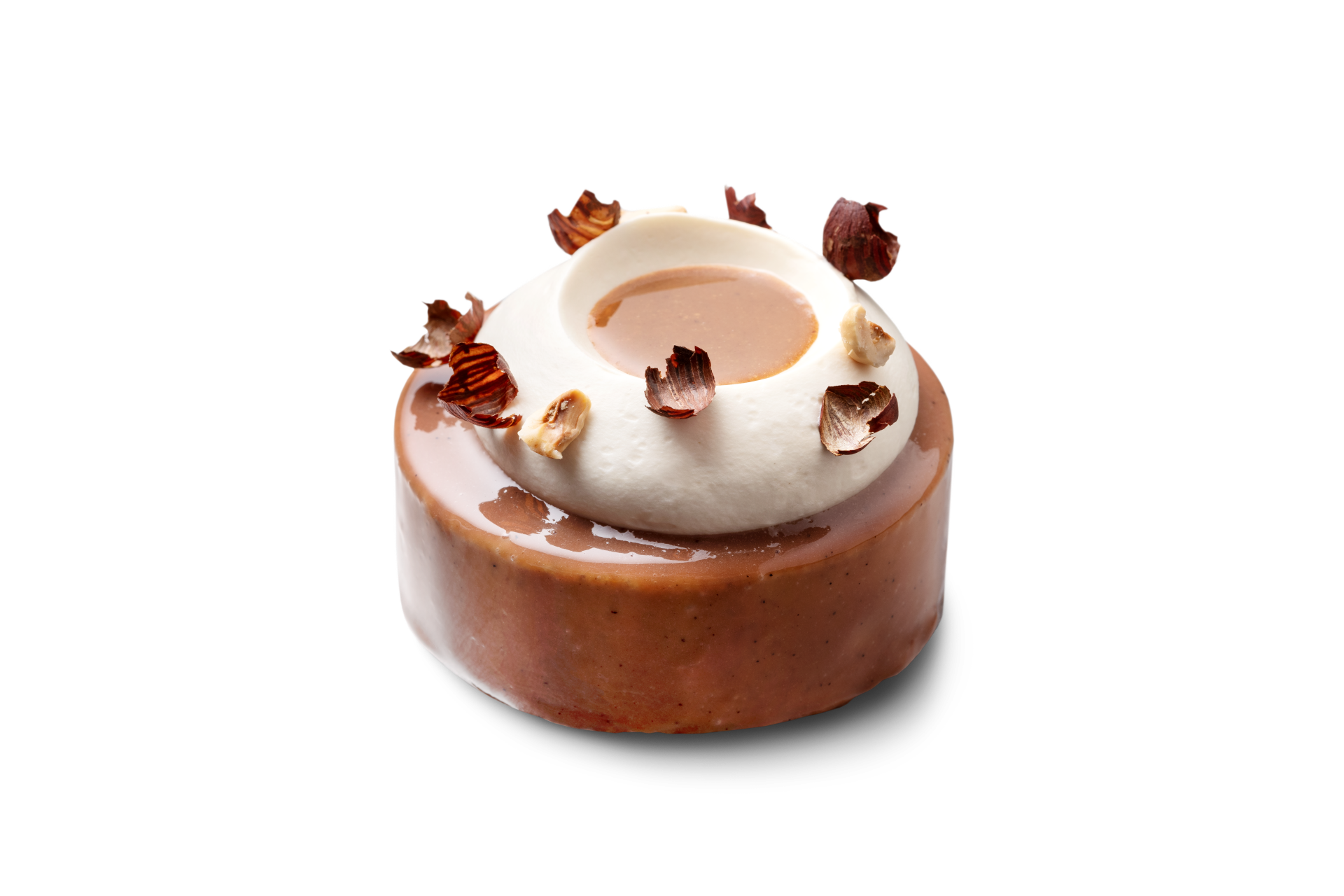Frequently asked questions
Want to know how to store our products, or do you have a question about ingredients or about specific techniques and packaging? Take a look at the list of frequently asked questions. Can’t find your question? Then you can get in touch with us via the contact form or by contacting your trusted representative.
How long after opening the package can I use the products?
Generally speaking, our products can be used for several days after opening. However, this can vary from product to product and we suggest that you visit the individual product pages on this site.
What is the shelf life of my final product once it’s been prepared in combination with other ingredients?
The shelf life depends on the maturity and quality of the other added ingredients. To ensure the longest possible shelf life, all preparation needs to be carried out in the most hygienic conditions.
What is the final expiry date of the products?
The final expiry date of the products depends on the type of product and the production process. In general, it can be assumed that, from the date of production, UHT products can be kept for at least 3 months and pasteurized products can be kept for least 10 days.
Specific expiry dates can be found on the product packaging.
What are the generally accepted storage conditions for Debic products?
All our UHT products must be kept refrigerated. To ensure optimum product properties and performance of our products, the advice is to store them between '+ 2°C and +7°C.
How should I store the Debic spray can during service times?
For best results, please keep for 24 hours in the refrigerator before use. Advised temperature is between 2 and 7 degrees Celsius. Do not freeze. During service times the SPC can be used directly from the refrigerator. After use we advise to clean the spray can and return the can to the refrigerator.
What is the best way to clean the Debic spray can?
1. For the best result, keep for 24 hours in the refrigerator before use. Do not freeze.
2. First break the safety seal on the cap by pulling the cap in prolongation of the can.
3. Open the handle and push the safety seal towards the inside (for the first time only).
4. Close the handle and sake 2 to 3 times before use (gently).
5. Hold the can upside down as close to the dish as possible, then press the nozzle.
6. Clean the handle. The nozzle can be taken off.
7. Return the can to the refrigerator.
Are Debic products healthy?
All Debic dairy products are made exclusively from the finest ingredients, which satisfy the most stringent requirements. All ingredients meet the national and international legal standards for food products. These ingredients are produced by verified breeders, who meet the quality standards as defined in the FrieslandCampina quality programme, ‘Foqus’.
Is the ingredient E471 of animal or vegetable origin?
E471 in Debic products is completely from plant base. This is suitable for vegetarians, vegans or anyone who wants to avoid animal origin products.
Marc Custine, Senior Product Developer Debic
Is Debic Vegetop lactose free?
No, Debic Vegetop products are not lactose-free, because they contain buttermilk. Buttermilk consits of lactose and millk protein. However, the butterfat is replaced with a mix of vegetable fats and this is the reason why we name it "Vegetop".
Marc Custinne (Senior Product Developer) & Sofie Vanderhasselt (Culinary Advisor)
Are Debic products gluten-free?
Yes, Debic products are gluten-free. Our cream products contain corn and corn is naturally gluten-free.
Marc Custinne (Senior Product Developer) & Sofie Vanderhasselt (Culinary Advisor)
What are the E-numbers in Debic products?
Food may lose properties (odor, color, taste, structure, etc.) during storage. Additives are aids that ensure that these properties are preserved until the moment of consumption. E numbers are additives approved by the European Union for use in food. If it appears that the additive is harmless and is accepted in all EU countries, the substance will receive an E-number. We as Debic always keep an eye on this legislation.
The aim of Debic is to add a minimum of additives while maintaining functional properties. We continuously improve our products and look for the balance in ingredients and the best functionalities of the product. We know that our customers also appreciate consistent quality and the shelf life of our products.
Debic tries to use as much as possible natural flavorings and colorings. Sometimes we have to choose differently because of the specific functionalities and costprices to be respected.
Why do some Debic products contain palm oil?
Palm oil is used in many products, because of its specific functional benefits. Besides, palm oil has the highest yield of all vegetable oils, and is also an alternative to transfat.
With respect to the usage of palm oils: Debic is RSPO certified. It is our aim to use only segregated sourced palm oils. Besides that, it is the aim of the developing teams to keep the amount and concentration of all used hydrogenated vegetable fats as low as possible.
What happens during the homogenisation process?
During homogenisation (an optional step after heating), you can split up different sized fat particles so that they all become roughly the same size by applying pressure.
This process changes the properties of the cream:
- whiter colour
- characteristics for whipping (e.g., higher expansion percentage)
- mouth feel
- stability
- flavour

Can I add alcohol to Debic Chocolate mousse?
It’s certainly possible to add alcohol. Debic Chocolate mousse is robust enough to use different types and strengths of alcohol.
How do you go about doing this?
Pour the chocolate mousse into the mixer.
Start the machine and add the alcohol.
5% alcohol gives enough flavour, but it depends on your personal preference as to how much you want to use. It is robust enough, so you can always add more alcohol if you like.
Technically speaking, Debic Chocolate mousse gives you the opportunity to personalise your desserts in a really simple way by adding alcohol.
You can watch all the steps in this video.
What does binding mean?
Cold binding:
Adding vinegar, lemon juice or wine to cream will cause a reaction with the proteins in the cream, which then thickens through a coagulation process.
Warm binding:
If cream is heated up, any water in the cream evaporates, which increases the viscosity of the cream. You can speed up this process by adding starch.
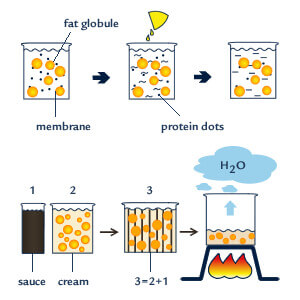
What does overrun mean?
This is an indication of how the cream behaves. The overrun shows the increase in volume as a percentage when a liquid cream is whipped. The volume after whipping is measured and compared to the original volume.
For example:
1 litre of liquid cream is whipped and results in a volume of 2.3 litres of whipped cream. The expansion percentage in this case is 230%.
What is separating?
Cream contains fat particles, among others. These fat particles are surrounded by a membrane containing various components (e.g. proteins). A cream is ‘separated’ when it no longer has a uniform structure or texture. This occurs when the fat particles break down (e.g. by heating or by adding an acid) and the proteins start to coagulate.
For example:
When you add a non-heat-resistant cream to a tomato soup, white dots (protein) appear when you heat it up. Debic Culinaire is a great solution to this problem, as it won’t separate. This cream is stabilized through our unique production method.

What is UHT?
UHT stands for ‘Ultra High Temperature’. This refers to a heating process whereby the products are exposed to very high temperatures (on average 140 ° C) for 4 seconds. In this way the products become bacteriologically sterile and thus have a longer shelf life. The main advantage of this production method compared to conventional sterilization is the preservation of the original characteristics of the product, including the fresh taste.
What is buttering?
When cream is overwhipped, it starts to turn into butter. The membranes surrounding the fat particles break down if the cream is whipped for too long. This, in turn, releases the fatty matter, which is able to clump together and form lumps of butter. The emulsion separates into a fat phase and a water phase.
What is meant by stand?
The stand of a cream refers to its rigidity when whipped after a certain amount of time has passed (12 or 24 hours). It is usually measured in a texture analyzer (TA), and is expressed in grams.
How can I recycle Debic PET bottles?
The recycling process of PET varies amonre regions and countries. We are continuously collaborating with all the parties to improve our packaging and working towards sustainabity.
How long can I use Debic spray can after opening it?
It is recommended to use Debic dairy cream with sugar in spray can best before the shelf life date. You can find this information at the bottom of the spray can. Please note that it only applies if you follow the instructions of cleaning the nozzle thoroughly after usage.
Anne Carmans, Development Food Services Belgium
How do I ensure to use SPC until the bottle is empty?
When the advised storage conditions (between 2 and 7 degrees Celsius) are followed, the total amount of cream will come out of the spray can.
An empty bottle is recognized when there is no cream coming out when the nozzle is pressed. Please shake the SPC max. three times before pressing the nozzle to have maximum result.


